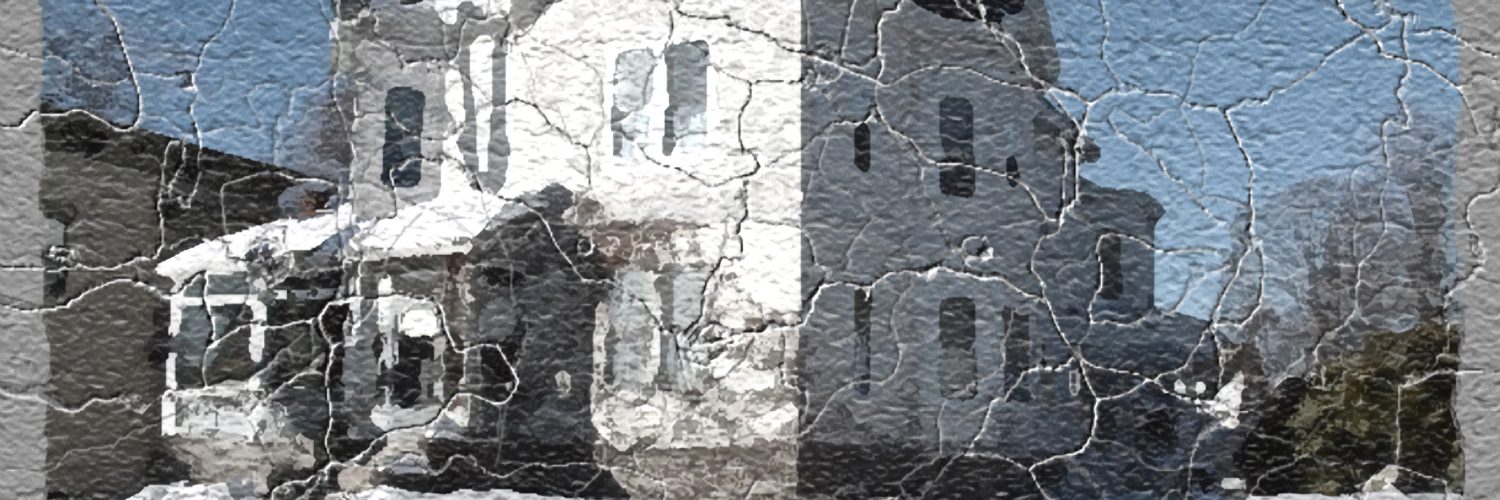by Neilson Caplain
First published in February/March, 2007, Volume 4, Issue 1, The Hatchet: Journal of Lizzie Borden Studies.
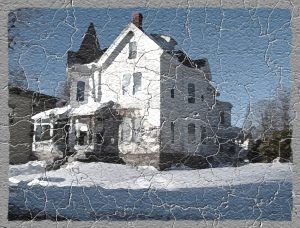 Lizzie was returning from her inspection of the stores on South Main Street. The route took her to Highland Avenue. As she rested comfortably in her carriage, Lizzie exulted in the impressive residences passed on the way. She was proud that her own home was just as much a credit to the neighborhood.
Lizzie was returning from her inspection of the stores on South Main Street. The route took her to Highland Avenue. As she rested comfortably in her carriage, Lizzie exulted in the impressive residences passed on the way. She was proud that her own home was just as much a credit to the neighborhood.
When the carriage arrived at French Street Lizzie noted on her right, across Highland Avenue, the imposing mansion inhabited by John Summerfield Brayton. Mr. Brayton was an attorney with extensive interest in the banking institutions of Fall River. He was also prominent in civic affairs, Mayor of the city at one time.
Lizzie knew Mr. Brayton, at a distance, because of her investments in his two banks. She also knew that in the financial depression just three years ago Mr. Brayton went to Boston and returned daily with enough currency to avoid default in the banks in which she had invested.
Of the fourteen banks in town Lizzie and her sister had inherited shares in three, and Lizzie investigated most of the others for possible further investment. You see, it was another inheritance she gained from her father: his business acumen.
Lizzie knew that the Braytons and the Durfees, with all their money, were an increasing influence in town, possibly even exceeding that of the Bordens.
Casting such thoughts aside, her carriage turned left to French Street, heading west, down the hill. Lizzie decided this would be a good opportunity to check on her neighbors, and the houses they lived in. She was an avid reader and her library contained books on art and architecture. She would use the latter to note the characteristics of each house as she passed by. It was such a pleasant hobby!
So she stepped down from her carriage and began a walking tour on the north side of French Street. The first house she encountered, on the corner of Underwood Street, was numbered 344. Mr. William F. Hooper lived there. Bill Hooper was a cotton broker with offices in the Metacomet Bank building. His partner was C.C. Buffinton, member of another prominent family in town. Lizzie would see Mr. Hooper on occasion, but as with all her neighbors, a nod and a hello, if even that, was all that passed between them.
Hooper’s father built the house about twenty years ago. It was Second Empire style, three stories. Perched on top of the mansard roof there was a cupola, with windows on all four sides. What purpose a cupola served she could never fathom. “Silly things,” she thought, “the only way to get up to them is by a ladder!”

Phoebe Davenport lived in the next house, Number 328. It was built circa 1879. Lizzie’s reference book pointed out that the house was in the Bracketed style. Phoebe was the widow of James F. Davenport. Her son, of the same name, was employed as a bookkeeper at the Wampanoag Mill. Lizzie noted that Simeon Borden, a distant relative, was a Director in that company.
One day Lizzie exchanged a few words with Phoebe, who explained that her husband had died eleven years ago. Her niece, Harriet F. Henry, a teacher at the high school, lived with her. Harriet was about five years older than Lizzie and Lizzie thought they could be friends. But Harriet showed no interest in any kind of relationship.
Lizzie stood before the next house, Number 318. It was an ordinary wood frame house of no particular style. Several families lived there. It was owned by James F. Kenney, a male nurse, of all things! His son, Wilfred, was a clerk somewhere or another. A boarder was Edward Whittum, a draughtsman for a company that made machinery for the cotton mills. Another roomer was Henry N. Simmons, a police officer. Lizzie would have nothing to do with him, even though he played no part in the murder case.
Now Lizzie stood before her own house. She and Emma bought it from Charles M. Allen very soon after the New Bedford jury pronounced her a free woman. Rumors abounded that they paid a handsome sum for the place, maybe as much as $14,000. “Let them think what they want,” was Lizzie’s reaction. “It’s not anyone’s business, and I’ll keep it among my secrets.”
Her home, now Number 306, was built only seven years ago, in what was considered the best part of town. The area was known as the Highlands. It was where the mill owners, bankers and merchants erected their residences. Lizzie’s house was built in the Queen Anne style. It stood near the top of the hill and afforded spectacular views of the Taunton River and the green fields of Somerset.
Lizzie planned to buy the Kenney house, east of her property. She would have it removed and replaced with a wide lawn. It was where her two dogs could run and frolic, where she could tend her birdhouses, always plentifully supplied with seed and crumbs. She would make friends of the gray squirrels that scampered to and fro and often approached unafraid to accept proffered tidbits. And she would build a spacious coach house for her carriages and horse that she took so much pride in owning.
At last Lizzie realized her dream. Now she would be able to assume her rightful place as a Borden in the upper echelons of Fall River society. “Surely,” she thought, “I will be invited to the dances, parties and dinners of the upper crust.” Alas, she soon found no such invitations were forthcoming.
“So be it,” Lizzie said to herself, “I will lead my own life. I’ll buy beautiful clothes. I’ll attend theater and visit museums in Boston and Providence. I will help deserving students advance their education at college. I will support an animal rescue society in the caring for horses and other animals.”
There is inscribed on a mantle in one of her rooms a line from a poem: “At Hame in My Ain Countrie.”
She thought of other lines from that poem which expressed her deepest feeling of searching and finding her place in this new life of hers:
And I’ll never be full content until my eyes do see,
the golden gates of heaven and my ain countrie.
Standing before her beautiful new home Lizzie could not help thinking of the house on Second Street where she had spent her years from adolescence to the date of the horrible murders that took place only four years ago.
In those days Lizzie had to endure a house without running water, except in the cellar and kitchen, a house where the only lighting came from oil lamps and candles. Other houses had gaslight and bathrooms. She thought wistfully, “I was ashamed to invite friends there. Father did not welcome visitors. I could never entertain a beau in such uncongenial surroundings.”
A picture arose unannounced in her mind—her father, stretched out on the sitting room sofa, his face slashed by an axe wielded ten times, her stepmother lying upstairs, bloodied with nineteen blows. Lizzie was accused of the murders. She spent ten months in jail before she was tried in New Bedford and adjudged not guilty. People said she must have done it, but could not have done it. What does Lizzie say? Nary a word, but to herself she maintained, “It’s a secret that I will carry to my grave.”
“In any case,” Lizzie’s reminiscences continued, “Emma and I have installed a beautiful monument in the Oak Grove cemetery. That’s where the well-known and rich families have their grave sites. Our monument was dedicated last year in January. There are buried Father, my mother who died when I was not yet three years old, little Alice who died when just a baby, and, of course, my stepmother, hateful old Abby Durfee Borden.”
With such somber thoughts Lizzie was reminded that her defense attorney Governor Robinson died this very year. And she was sorry to learn that Southard Miller died last year. He had lived in the double house opposite her old place at 92 Second Street. “Mr. Miller’s daughter, Phoebe, and her husband, Dr. Bowen, were my best neighbors and they stood up for me at the trial. Mr. Miller’s son, Franklin, is a talented artist. He helped, with Robert Dunning, to create what came to be known as the Fall River style of still life painting.”
“Tut, tut,” Lizzie thought. “Enough of such thoughts. I will get on with my walk.” So she passed her house and came before the Italianate home of the lawyer Marcus Swift at Number 294. It was built some time between 1875-1881 on the northeast corner of French and Belmont Streets. Lizzie remembered passing by Mr. Swift’s office on South Main Street. He was well known in the courtrooms in Fall River. Her father had dealt with lawyer Swift in connection with some land transactions.
Across Belmont Street, on the corner, stood a Bracketed style house built around 1874. It was inhabited by John H. Pitman and George H. Eddy, Jr., at Number 264. The former was a carpenter while Mr. Eddy was cashier at the Fall River National Bank. This house was the first of only two houses facing French Street on this block.
The second house on the block was the home of James T. Milne, a broker dealing in cotton cloth. His house on the block, Number 254, was the Victorian style erected in 1883. He must be a relative of John C. Milne, Lizzie speculated, who lived nearby on High Street.
Arriving at the corner, Lizzie found the next house to be facing High Street, Number 715. She took the few steps around the corner and stopped to admire one of the oldest houses around. It was built some thirty-six years ago. The book termed it High Victorian Italianate in style. The owner was J.P. Prentiss, Secretary of the Fall River Board of Trade.
Now the hill became steeper and more than once Lizzie faltered and almost lost her balance as she crossed to the opposite side of High Street where she admired the house at 710 High. It had just been built and it exemplified the Queen Anne Shingle style of architecture. She found out that the owner was a Mr. Cornell, who was a teller at the Massasoit Bank.
Again walking on French, Lizzie gazed on the house built in the Second Empire style, circa 1875. It bore the number 186, and had been built by Elkanah Whitely.
The only other house on this block was on the corner of French and Rock Street and was the home of O. Elton Borden. The house was numbered 162 and constructed somewhere around 1875. Elton Borden was a teller at the Second National Bank. Lizzie did not know this Borden. “But they must be related somehow,” she thought. “Just as I am related to all the other Bordens in town. The connection goes way back to old Richard Borden who came to this country in the 1600s.”
Back on French Street the tiring spinster came upon the Italianate home built by Leander Borden in 1881. Mr. Borden’s grandfather was active in banking circles. He was the first cashier at the Massasoit National Bank. Leander retired many years ago and died two years ago. His widow, Ariadne, lived there now. Lizzie felt some surprise that so many banking people lived on her street.
Further along, Number 132 French Street, Queen Anne style, was also erected in 1881. The owner then was Henry Buffinton who died only last year. Patrick J. Hurley, a partner in the firm of Tuttle & Milne, cotton brokers, now inhabited the domicile.
Number 116 was the home of Arba Lincoln, a well-known lawyer in town. Lizzie harbored kind thoughts of Mr. Lincoln. It was he who complained about not receiving fair treatment from Josiah Blaisdell, Justice of the Second District Court. This was the same Blaisdell who declared her probably guilty at the preliminary hearing in 1892. Lizzie could never again have warm feelings for the Judge.
Arba’s complaint went before the Bar Association. No action was taken because of Judge Blaisdell’s resignation. Lizzie, with thin lips and cold eyes muttered, “He said he resigned because of ill health, but we know better, don’t we?”
Lizzie noted that Mr. Lincoln’s house was erected around 1880 in the Victorian style so popular in those days.
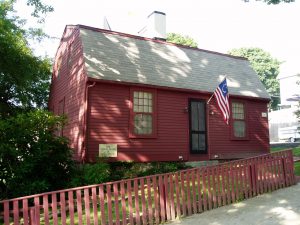
Number 96, the Church house, was next on the northeast corner of French and June Streets. Lizzie searched her reference book and found that it was the oldest house in Fall River, built before the Revolution, perhaps as early as 1750. The present inhabitant is Mr. George Church, listed in the city directory as a machinist.

Further along French Street was not considered “on the Hill,” so Lizzie was not interested. Down there were the wood frame houses of mill workers, clerks and day laborers of poor to moderate means. Some were French Canadians brought to Fall River to work in the many new cotton cloth mills.
So Lizzie crossed June Street to the south side of French Street. The first house, facing June Street, was the home of Andrew J. Jennings. It had been built in 1881 and was considered Stick style and bore the number 421.
Lizzie had bittersweet feelings. Jennings was one of her defense lawyers at the trial in 1893. He sincerely believed in her innocence and she was grateful for his efforts in her behalf. She had hopes that the relationship would continue. For some reason, a mystery to her, Mr. Jennings distanced himself from her affairs and she had little to do with him now. She understood Mr. Jennings was presently involved in politics. He was elected District Attorney soon after the conclusion of the trial.
Lizzie continued her trek up French Street. There were no houses on the block facing French Street but on the southwest corner with Rock Street stood the house of Griffitts Haffards at Number 682. This gentleman was widely known as a banker-broker. He had built his home in the Queen Anne style in 1884. Lizzie appreciated the fine details, the wrap-around porch, and the peaked corner roof.
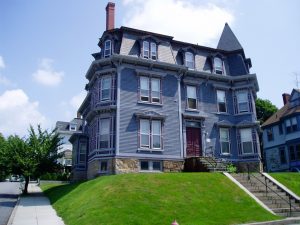
Opposite the Haffards house, on the southeast corner of Rock and French Streets was the imposing abode of Franklin L. Almy. The structure was built in 1883, Second Empire form of architecture, and numbered 685. Mr. Almy was on the Board of Investment of the Citizens Savings Bank. With John C. Milne, he was the publisher of the Fall River Daily and Weekly News. Lizzie mused wistfully on the considerate reporting by these newspapers of her ordeals in 1892 and 1893. Not at all like the awful Boston Globe and its aptly named reporter, Henry Trickey.
Almost out of breath, Lizzie stood still for a moment. She marveled at the number of houses that were erected after the end of the Civil War. They clustered in the Highlands along Rock, High and nearby streets. That was a time of prosperity in Fall River—business was expanding and public buildings were constructed. The mills were humming, on the way to attaining leadership in the manufacture and printing of cotton cloth. All in all, a happy future prospect for Lizzie A. Borden, whose considerable wealth was still invested in real estate, banks and cotton mills.
Finding no other houses on that block, Lizzie came to High Street and crossed over to the east side. There she met the Greek Revival home of Isaac Borden at 687 High Street. Mr. Borden was an insurance agent.
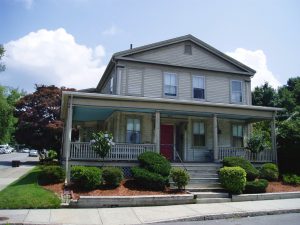
Back on French Street her first encounter was the site where a new house was being constructed. It would bear the number 243. Lizzie believed it was to be the home of Elizabeth McWhirr, the widow of R.A. McWhirr. He had been the owner of the largest department store in the city. It was on South Main Street. Lizzie was impressed by the nicely decorated window displays she saw as she passed by the store a few days ago. The McWhirr company advertised in the city directory, “To give the new and desirable at lower prices than elsewhere is ever our desire.”
Benjamin Cook occupied the next house, Number 257. His son, Benjamin Cook, Jr., lived in the same house. He was in the legal profession and was quite successful and well known in Fall River. Their house was on the corner of Belmont Street.
Lizzie crossed over to find the house of John S. Brayton, Jr., at 97 Belmont Street. It was a Shingle style house, built in 1890.
Now at last, Lizzie came upon the house just opposite her beloved residence. There stood the Edward B. Lake house, Number 309, built around five years ago in the Queen Anne style. Mr. Lake was a partner in the popular grocery company, Allen, Slade & Co., which owned several stores in town, one on Second Street, not far from her old home.
Lizzie took a deep breath. Before crossing to her home unwanted thoughts invaded her mind. She had tried to erase remembrances of the murder trial three years ago. The trial no longer was real—it existed only in her brain. The scenes were etched as indelibly in her mind as deep scratches in mahogany wood
“I was forced to listen to the passionate appeals by Attorney Knowlton to call me guilty. I sat through the frightening testimony of Marshal Hilliard, Assistant Marshall Fleet, and the other officers in the police department all of whom testified against me. One painful picture is of Alice Russell, supposedly my friend, disclosing the incident of the burning dress. Worst of all was the day they brought out the broken skulls of Father and Abby. I remember I could not be in the room when they did that.”
With huge effort Lizzie turned her thoughts elsewhere. Satisfied now that she knew who lived in the houses along her street she was made painfully aware that her neighbors were aloof, even unfriendly.
But she took comfort in her own residence. She entered the house, settled comfortably in the sitting room, and called for the maid to bring tea and biscuits. Then Lizzie fell asleep and dreamed of theaters and museums and lovely stores in other cities where she was unknown and secure in the “Not Guilty” verdict of twelve men good and true.


